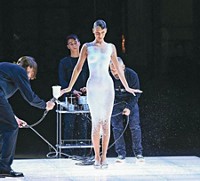Advertisement
Grab your lab coat. Let's get started
Welcome!
Welcome!
Create an account below to get 6 C&EN articles per month, receive newsletters and more - all free.
It seems this is your first time logging in online. Please enter the following information to continue.
As an ACS member you automatically get access to this site. All we need is few more details to create your reading experience.
Not you? Sign in with a different account.
Not you? Sign in with a different account.
ERROR 1
ERROR 1
ERROR 2
ERROR 2
ERROR 2
ERROR 2
ERROR 2
Password and Confirm password must match.
If you have an ACS member number, please enter it here so we can link this account to your membership. (optional)
ERROR 2
ACS values your privacy. By submitting your information, you are gaining access to C&EN and subscribing to our weekly newsletter. We use the information you provide to make your reading experience better, and we will never sell your data to third party members.
Education
Finishing ‘Chemical-Free,’ Fashionable MOFs
by Carmen Drahl
July 11, 2011
| A version of this story appeared in
Volume 89, Issue 28

The pages of Newscripts are replete with examples of merchandise marketed with the nonsensical slogan “chemical-free.” Usually, the Newscripts gang writes these things up in the magazine, lets out some combination of a chuckle and a sigh, and moves on. But last month, a few chemists and journalists banded together to keep the movement going on a more regular basis and wipe the term chemical-free off the marketing map.
I got involved while covering June's National Organic Chemistry Symposium at Princeton University (see page 33). I spotted a colorful chalkboard outside an eco-friendly gift shop in downtown Princeton that was touting chemical-free sunscreen and bug spray. But I didn’t have the time or inclination to lecture the shopkeeper on misleading advertising. So I did what any enterprising chemistry reporter would do: I snapped a picture of the offending sign with my phone and uploaded it to the microblogging website Twitter.
My tweet caught the attention of Mary Carmichael, a frequent contributor to Newsweek. In response, she created a photo blog (http://bit.ly/krudzJ) where she solicits images depicting chemical-free products. A few days later, on June 12, Pulitzer Prize-winning author Deborah Blum of the University of Wisconsin, Madison, included my photo in an engaging blog post bemoaning a New York Times piece on chemical-free makeup (http://bit.ly/qUcSqj).
In response to the bloggers’ work, Matthew Hartings, an assistant professor of chemistry at American University, wrote an eloquent essay about rebranding the term chemical-free (http://bit.ly/iybPxV). He also solicited ideas for alternatives to the term. Hartings and Carmichael are still accepting chemical-free suggestions, so Newscripts readers should feel free to log on and weigh in.

The garments Jennifer Keane has designed at Cornell University are decidedly not chemical-free. (Chemical-free clothing probably wouldn’t fly in a family magazine like C&EN anyhow.) Her masks and hoods are made to absorb chemicals, in particular the harmful gases that could endanger construction workers or firefighters.
The secret behind this chemical-capturing couture? It’s a fiber impregnated with metal-organic frameworks (MOFs), which are cagelike compounds that can be customized to trap different chemicals. The material is the fruit of a collaboration between Keane’s adviser, Juan P. Hinestroza, a professor of fiber science at Cornell, and Omar M. Yaghi, an MOF pioneer at the University of California, Los Angeles. Hinestroza tells Newscripts that marrying MOFs and fibers wasn’t easy at first. But postdocs Marcia Silva da Pinto and Cesar Sierra managed to “make it work” by using the fiber as a scaffold to build the MOF.
In addition to keeping workers safe, the MOF that the team chose for its prototype makes fabrics pleasing to the eye. The copper in the MOF lends a turquoise tint to the fibers, Hinestroza explains.
Because Keane received course credit for the design, her MOF creations were ineligible to hit the catwalk at Cornell’s spring fashion show. But the student designer has a bright future ahead—she’s accepted a job with Adidas.
“Working with a designer was a great experience,” both from learning and teaching perspectives, Hinestroza says. “You know you really know something when you can explain it to someone else, and through fashion, I was able to teach concepts of covalent bonding, color chemistry, and oxidation states.”




Join the conversation
Contact the reporter
Submit a Letter to the Editor for publication
Engage with us on Twitter